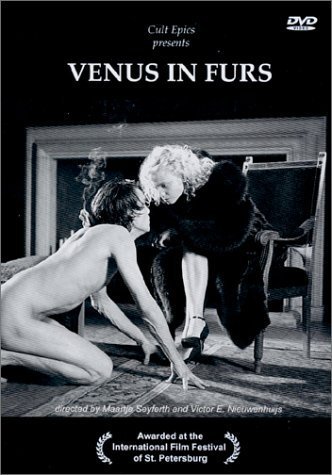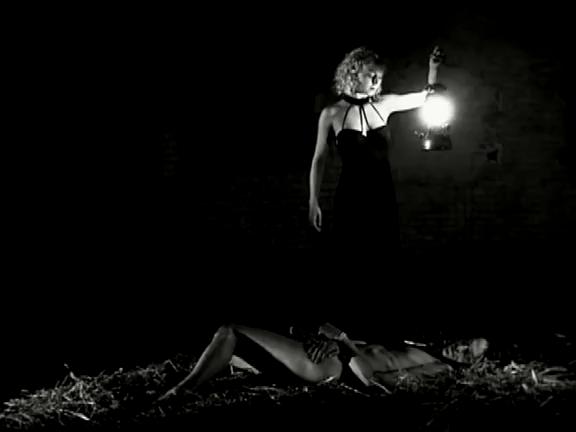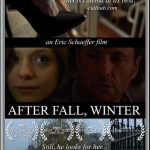
Written, produced and directed by Victor Nieuwenhuijs. Starring Anne van de Ven as Wanda, and André Arend van de Noord as Severin. IMDB
(Unless otherwise stated, all quotes are from English dub, not the English subtitles.)
Unlike the 1967 Venus in Furs or the 1969 Jesus Franco Venus in Furs, this is pretty close to the original story, though set in the present day. Severin, a young man, falls for a young woman named Wanda. They sign a contract to formalize their dominant-submissive relationship.

There are several scenes extracted from the novel, though modified as this is a low budget film. (It often feels like a filmed stage play.) They travel by train, where Severin plays “Gregor” her servant, who watches from outside the compartment as Wanda flirts with another man. In another scene, three black women chase him down and tie him to a cart to pull, while Wanda stands on a distant hill, nude.
In voice-over, Severin talks about how he read a book about Christian martyrs at age 10, “I read it with a revulsion bordering on voracious ecstasy. They languished in dungeons, were roasted above a small fire, pierced with arrows, had pitched poured over them, were nailed to a cross. All of this they underwent in a state of intoxication.” This is consistent with the original novel and Sacher-Masoch’s other writings, which often had elements of religious rituals.

Since almost the entire film is in Severin’s POV (there are some frontally nude shots of the male lead), it’s often unclear if any particular scene is something that is actually happening or is something Severin is fantasizing or dreaming. This matches Severin’s constant insecurity about Wanda: Is she doing this to please him, or because she enjoys herself in this role? Will she leave him because she has tired of this role, or because she has discovered her own submission to another man, or because she has realized that the cruelest thing she could do to him is abandon him? Or is she trying to be as cruel as possible to exceed his desire and “cure” him of this? Or has he awakened some latent, uncontrollable sadism in her? There’s a lot of push-pull between the two leads.
Old joke: “The masochist says, ‘Hurt me.’ The sadist says, ‘No.’” That’s the unsolvable paradox that drives the book and this movie. Both Severin and Wanda struggle with the idea that cruelest and most powerful thing Wanda could do is leave Severin. In other words, the way to “win” the game is to end it. Severin has to keep cajoling Wanda into playing the game.
In the climactic scene, the camera takes Severin’s POV as Wanda hands over the black fur coat and riding whip to a man (analogous to “the Greek” in the original) who proceeds to beat and brand him, while in the background, Wanda, nude, kneels at the feet of another, fur-clad woman. Not only is Severin “forced” to submit to a man wearing the fetishized symbols, he “has to” watch Wanda submit to someone else, abdicating the role he has assigned her.
The idea that female dominance/male submission is a relationship that cannot be resolved romantically has turned up in other films (e.g. Something Wild (1986), Preaching to the Perverted (1997)) (unlike the romantically successful male dominant/female submissive relationships, e.g. Secretary (2002), the Fifty Shades trilogy (2015-18)) . The more I think about this, the more I am unconvinced that a femdom-malesub romance is impossible. There must be some way to do it, even if it goes against the “rules” of heterosexual romance.
Venus in Furs is a thematically faithful adaptation of the original novel.
In researching this film, I also found references to another adaptation of Venus in Furs, directed by Aryan Kaganof (co-writer of the 1995 film) and released in 2001. There’s no mention of it in IMDB, however. There was also a Korean film adaptation in 2015.



